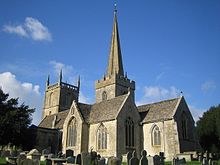St Mary's Church, Purton
| St Mary's, Purton | |
|---|---|
| Church of St Mary the Virgin | |
 |
|
| Coordinates: 51°35′00″N 1°51′42″W / 51.5833°N 1.8616°W | |
| OS grid reference | SU 0968487172 |
| Location | Purton, Wiltshire |
| Country | England |
| Denomination | Anglican |
| Architecture | |
| Status | Parish church |
| Functional status | Active |
| Heritage designation | Grade I |
| Designated | 17 January 1955 |
| Administration | |
| Deanery | Swindon |
| Archdeaconry | Malmesbury |
| Diocese | Bristol |
| Province | Canterbury |
St Mary's Church is in the village of Purton in north Wiltshire, England. It is an active Anglican parish church in the Diocese of Bristol. It is one of only three churches in England to have both a western tower and a central spire. It has been designated a Grade I listed building by English Heritage.
There was a church at Purton no later than the 12th century; a capital from that time still exists in the wall of the nave, which was built in the early 13th century. The chancel dates from the late 13th century. The central tower, transept and a chapel south of the chancel were added in the 14th century.
Restoration was carried out in 1872 by William Butterfield, when three walls of the chancel were rebuilt. At this time a skeleton was discovered in a wall of the north transept.
Nevil Maskelyne FRS (1732-1811), the fifth British Astronomer Royal, is buried in the churchyard.
The church is constructed of coursed rubble limestone, with roofs of slate and lead. Its plan consists of a three-bay nave with aisles, a tower to the west and a transept. Above the crossing is a steeple. There is a chancel, and a porch to the south. The west tower has angled buttresses and three stages; the upper stage has three-light belfry louvres, with perforated stone screens. The tower has crocketed pinnacles at its corners and a stair turret to the north corner. The central steeple has two-light belfry louvres and a crenellated parapet. The spire is octagonal. St Mary's is one of only three churches in England to have both a western tower and a central spire. The church houses a ring of eight bells hung for change ringing and a Sanctus bell. The first and second bells (the lightest) were cast in 1989, and the seventh in 1916 by John Taylor & Co of Loughborough; the third and fifth by Gillett & Johnston of Croydon in 1924 and 1923 respectively; the fourth by Robert Wells II in 1793; the sixth by Joseph Carter in 1598, the largest bell known to have been cast by this founder; and the tenor (heaviest) by Abel Rudhall of Gloucester in 1738. Rudhall also made the Sanctus bell, cast in 1760.
...
Wikipedia

